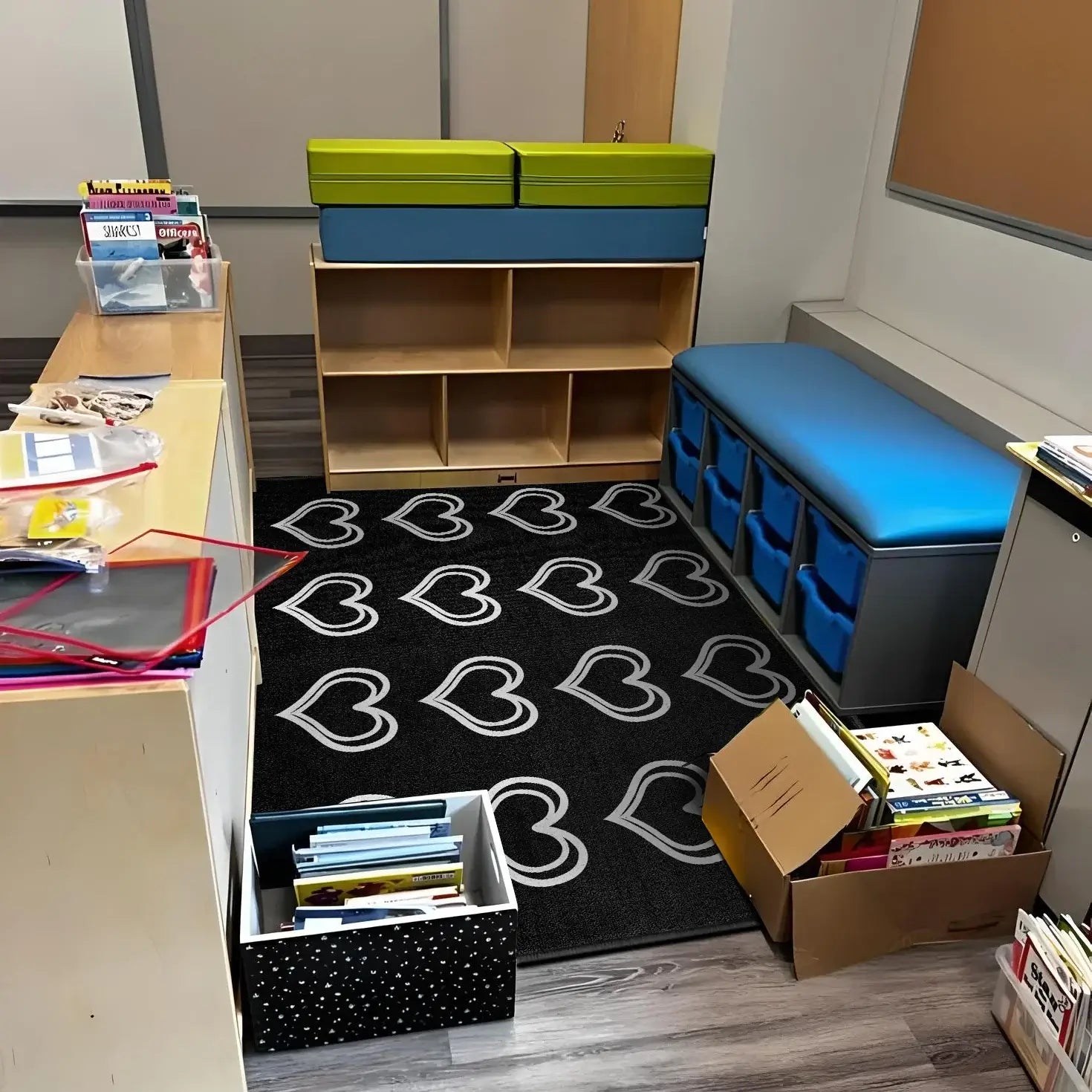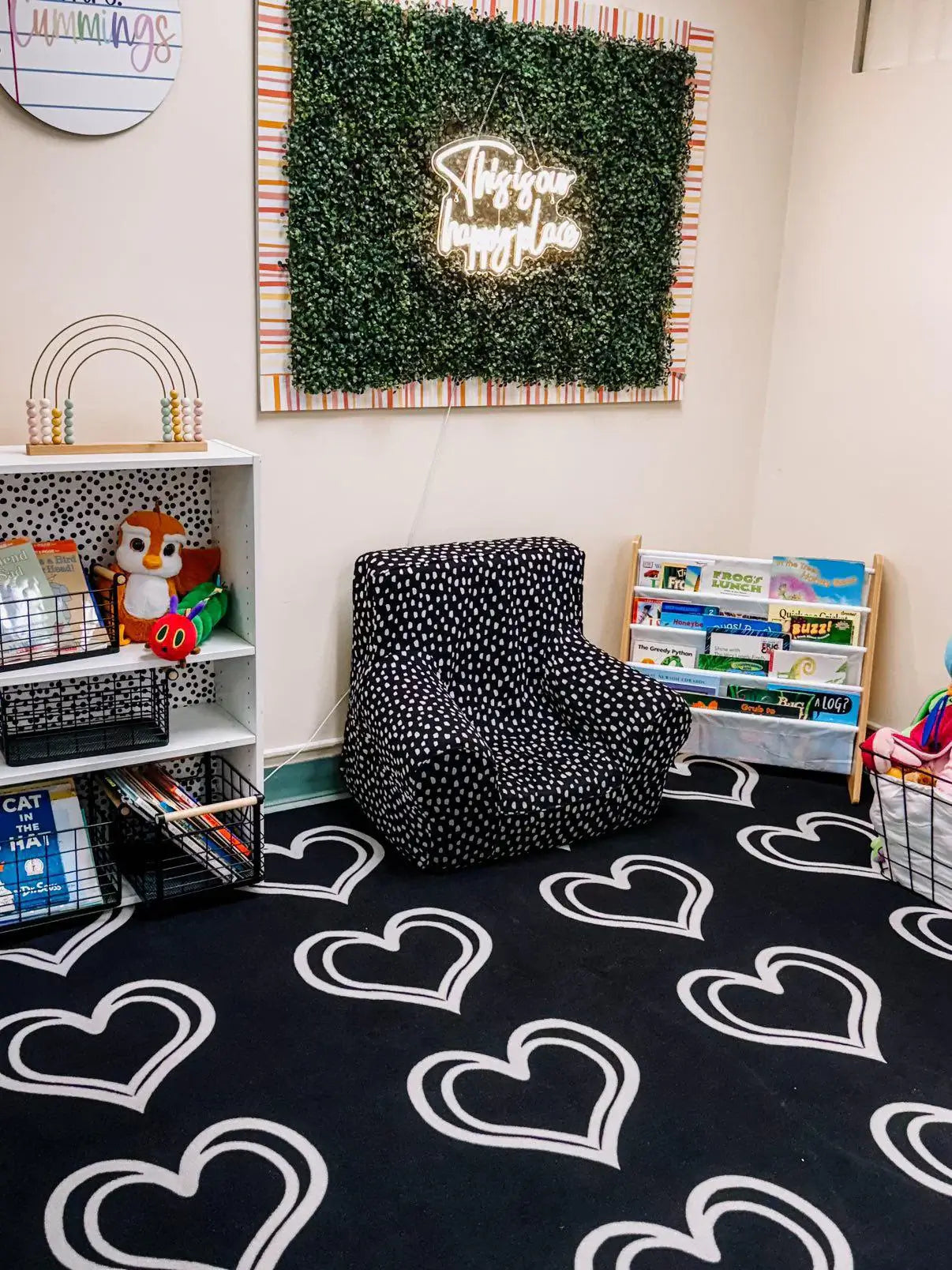Understanding Learning Diversity in Modern Classrooms
Educational diversity encompasses far more than traditional categories of special needs or language differences.
Modern classrooms include visual learners, kinesthetic processors, introverted students, high-energy children, culturally and linguistically diverse populations, and students with varying socioeconomic backgrounds.
Each brings unique strengths and challenges that effective classroom design must address.
Research from the National Center for Education Statistics shows that diverse learning environments improve outcomes for all students, not just those with identified differences.
Strategic use of classroom rugs creates flexible spaces that adapt to various learning preferences while maintaining cohesive classroom communities.
Supporting Multiple Learning Modalities
Visual Learning Enhancement
Many students process information most effectively through visual channels.
Classroom rugs with educational graphics, clear organizational patterns, and high-contrast designs provide constant visual reinforcement that supports comprehension and retention.
Maps, alphabets, number systems, and geometric patterns embedded in rug designs serve as learning aids that benefit visual processors.
Kinesthetic Learning Opportunities
Students who learn through movement and physical interaction thrive when classroom rugs provide designated spaces for active learning.
Floor-based activities allow these learners to engage with content through manipulation, movement, and hands-on exploration that traditional desk-bound instruction cannot provide.
Auditory Processing Support
Soft rug surfaces improve classroom acoustics by reducing echo and background noise that can overwhelm students with auditory processing sensitivities.
This acoustic improvement benefits all learners but particularly supports those who struggle with auditory discrimination or attention challenges.
Cultural Responsiveness and Representation
Inclusive Imagery and Patterns
Classroom rugs should reflect the cultural diversity of student populations while avoiding stereotypes or tokenism.
Choose designs that celebrate various cultures through respectful representations of art, symbols, and traditions that make all students feel valued and recognized.
Global Perspectives Integration
Educational rugs featuring world maps, international landmarks, or multicultural themes create opportunities for discussions about different cultures and perspectives.
These visual references support culturally responsive teaching practices that connect learning to students' lived experiences.
Language Support Features
Multilingual rugs or those featuring diverse alphabets support English language learners while exposing all students to linguistic diversity.
These design elements normalize multilingualism and create pride in heritage languages.
Accommodating Physical Differences and Abilities
Accessibility Considerations
Classroom rugs must accommodate students with mobility devices, physical disabilities, or other accessibility needs.
Consider pile height, edge transitions, and spatial arrangements that ensure all students can participate fully in rug-based activities.
Sensory Processing Support
Students with sensory processing differences require careful attention to texture, color intensity, and pattern complexity.
Some children need deep pressure input from textured surfaces, while others require smooth, calming textures. Sensory-friendly classroom design principles guide appropriate rug selection.
Positioning and Movement Options
Diverse learners benefit from various positioning options during rug activities. Some students focus better while standing, others need to fidget or move, and some require specific seating arrangements.
Explore our full range of classroom rugs by activity to support circle time, movement learning, and quiet reading—all within the same flexible classroom setup.
Supporting Social-Emotional Learning Differences
Creating Safe Spaces
Classroom rugs define areas where students can feel psychologically safe to take risks, make mistakes, and engage authentically with learning content.
This safety becomes particularly important for students who have experienced trauma, discrimination, or academic struggles.
Building Community and Belonging
Circle time and group activities on seating rugs foster connections between diverse learners.
These shared experiences build empathy, understanding, and friendship across difference while developing crucial social skills.
Emotional Regulation Support
Designated rug areas can serve as calm-down spaces where students practice emotional regulation strategies.
The soft, contained environment provides comfort during overwhelming moments while teaching self-advocacy and coping skills.
Economic and Social Diversity Considerations
Eliminating Barriers to Participation
Ensure that rug-based activities don't inadvertently create barriers for students from different economic backgrounds.
Avoid requiring special clothing, materials, or supplies that some families cannot provide, focusing instead on inclusive activities that welcome all participants.
Honoring Different Family Structures
Design rug activities that accommodate various family configurations and living situations.
Projects involving family members should offer flexibility for students in foster care, those with deployed parents, or children living with grandparents or other caregivers.
Learning Style Accommodations
Introverted vs. Extroverted Learners
Some students thrive in group rug activities while others prefer quieter, more individual experiences.
Create options for both preferences through varied activity structures and flexible participation levels that honor different social comfort zones.
Processing Speed Differences
Students process information at different rates, requiring activities that can accommodate both quick processors and those who need additional thinking time.
Rug-based learning should offer multiple entry points and varied complexity levels.
Attention and Focus Variations
Children with ADHD, autism, or other attention differences benefit from structured rug environments with clear expectations and sensory supports.
Consider fidget-friendly textures, defined personal spaces, and movement opportunities that support sustained attention.
Technology Integration for Diverse Needs
Assistive Technology Compatibility
Modern classroom rugs must accommodate various assistive technologies including communication devices, hearing aids, and mobility equipment.
Ensure adequate space and appropriate surfaces for technology use during rug activities.
Adaptive learning technology Integration
Interactive rug systems can connect with adaptive software and personalized learning platforms that adjust to individual student needs.
This technology integration supports differentiated instruction while maintaining inclusive group experiences.
Assessment and Evaluation Adaptations
Multiple Demonstration Methods
Rug-based activities should offer various ways for students to demonstrate learning, accommodating different communication styles, physical abilities, and comfort levels.
Some students excel in verbal discussions while others prefer movement, drawing, or written responses.
Progress Monitoring for All Learners
Track engagement and learning across diverse student populations to ensure that rug activities benefit everyone equally.
Regular assessment helps identify students who may need additional supports or alternative approaches.
Professional Development for Inclusive Practice
Cultural Competency Training
Teachers need ongoing professional development to effectively serve diverse learners through environmental design choices.
Understanding how classroom rugs can support or hinder different populations requires cultural awareness and sensitivity training.
Disability Awareness and Accommodation
Educators must understand how various disabilities and differences impact learning in rug-based environments.
This knowledge informs appropriate accommodations, modifications, and universal design principles.
Family and Community Engagement
Honoring Home Cultures
Invite families to share cultural traditions, languages, and perspectives that can be incorporated into rug-based learning activities.
This engagement builds bridges between home and school while enriching the educational experience for all students.
Communication About Inclusive Practices
Help families understand how diverse classroom environments benefit their children. Clear communication about inclusive design choices builds support for innovative teaching practices.
Implementation Strategies for Success
Gradual Introduction and Adjustment
Introduce inclusive rug practices gradually, allowing time for students to adjust to new expectations and experiences. Monitor comfort levels and make modifications based on student responses and needs.
Peer Support and Buddy Systems
Pair diverse learners strategically during rug activities to build natural supports and friendships. These partnerships benefit all participants while creating inclusive classroom communities.
Measuring Impact and Effectiveness
Engagement Across Populations
Track participation rates, enthusiasm levels, and academic growth across different student groups to ensure that inclusive rug practices benefit all learners equally.
Social Integration Indicators
Monitor improvements in peer relationships, reduction in bias incidents, and increased cross-cultural friendships that often result from inclusive classroom design practices.
Academic Achievement Equity
Assess whether diverse learning supports through rug-based instruction help close achievement gaps and improve outcomes for historically underserved student populations.
Addressing Implementation Challenges
Resource Allocation and Equity
Ensure that inclusive rug selection doesn't inadvertently favor certain groups while neglecting others. Balanced design choices require careful consideration of all student populations served.
Teacher Comfort and Confidence
Support educators in developing skills and confidence to facilitate inclusive rug activities that serve diverse learners effectively. Ongoing coaching and collaboration improve implementation quality.
Future Directions in Inclusive Design
Emerging Research and Best Practices
Stay current with evolving research on inclusive education, neurodiversity acceptance, and culturally responsive teaching practices that inform effective classroom rug implementation.
Technology Advances and Accessibility
Monitor developments in assistive technology, interactive learning systems, and adaptive design that can enhance rug-based learning for diverse student populations.
Conclusion
Classroom design for diverse learners requires intentional choices that recognize and celebrate the full spectrum of human differences while creating equitable learning opportunities for all students.
Classroom rugs, when thoughtfully selected and strategically implemented, serve as powerful tools for inclusion that support academic success and social belonging.
The investment in inclusive rug design pays dividends through improved engagement, reduced behavioral challenges, stronger classroom communities, and better academic outcomes across all student populations.
As education continues evolving toward more inclusive practices, classroom rugs represent accessible, cost-effective strategies for creating learning environments where every student can thrive.
Success in diverse classrooms comes not from treating all students identically, but from recognizing individual needs while building cohesive learning communities.
Classroom rugs provide the foundation for this balanced approach, creating flexible spaces that adapt to learner differences while fostering the connections and understanding essential for our increasingly diverse society.




Leave a comment
This site is protected by hCaptcha and the hCaptcha Privacy Policy and Terms of Service apply.